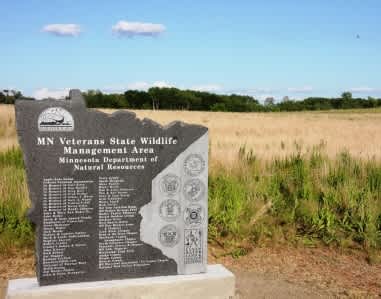New, 604-Acre Veterans State Wildlife Management Area Opens near Clearwater
Pheasants Forever 07.24.14

More than 600 acres in Minnesota’s Stearns and Wright counties have been permanently conserved in honor of Minnesota’s military veterans. The Veterans State Wildlife Management Area is now open to public hunting and outdoor recreation. Located south of Clearwater, the project was created in part by funding from Minnesota’s Outdoor Heritage Fund (created by the Clean Water, Land and Legacy Amendment) and Pheasants Forever’s “Build a Wildlife Area” program.
The 604-acre Veterans State Wildlife Management Area stands out as a large, permanently protected area of wildlife habitat near the Twin Cities metro region and will serve as a memorial to the sacrifices made by military servicemen and women. The area, now managed by the Minnesota Department of Natural Resources, will be open to public hunting and outdoor recreation in perpetuity.
“Wildlife habitat conserved forever not only functions as a fitting tribute to those who served, it will always be there to fulfill the outdoor passions so many veterans have,” says Joe Duggan, Pheasants Forever’s Vice President of Corporate Relations.
“This land donation in honor of our state’s heroes is an excellent example of support from Pheasants Forever and the larger community,” said Larry Shellito, Commissioner of the Minnesota Department of Veterans Affairs. “The Veterans State Wildlife Management Area not only honors our veterans, but serves as a permanent reminder of the sacrifices made by our servicemen and women. For generations to come, veterans and outdoor enthusiasts alike can utilize this area and enjoy all our state’s wildlife resources have to offer.” The Veterans State Wildlife Management Area project was supported by the Department of Veterans Affairs and the Minnesota Commander’s Task Force.
About half of the Veterans State Wildlife Management Area property consists of extremely diverse, high-quality restored native prairie. The remainder is a combination of mature oak woodland, wetlands and riparian – the Clearwater River runs for a half mile through the property. This new wildlife area is also within a mile of the existing 1,000-acre-plus Succonix Wildlife Management Area, so the two units complement each other and build a corridor of publicly-accessible wildlife habitat.
Corporate support for the Veterans State Wildlife Management Area was provided by Apple Auto Group, Federal Premium Ammunition, Outdoor News, employees of Graco, Muller Family Theatres, Rassat Outdoor Group, MobileStrong, Beerforwildlife.com and the Del-Tone/Luth Gun Range. Additional partners include the U.S. Fish and Wildlife Service, the Minnesota Waterfowl Association – Tri County Chapter, National Wild Turkey Federation, Minnesota Deer Hunters Association (including the Crow River, Sherburne County, Swampbucks and North Suburban chapters) and the Minnesota Lady Slippers, Mississippi Longtails, Anoka County, Wright County and Stearns County Pheasants Forever chapters. The project was completed thanks to the Smith family and many individual donations and memorial gifts.
To date, Pheasants Forever’s Build a Wildlife Area program has completed more than 25 projects in three states, permanently protecting more than 6,000 acres of wildlife habitat – all open to the public for hunting and outdoor recreation.
The new Veterans State WMA is located near Clearwater, Minn. From the I-94 interchange in Clearwater, take State Hwy. 24 south 3.5 miles. The Wildlife Management Area parking lot is on the left (east) side of the highway.

